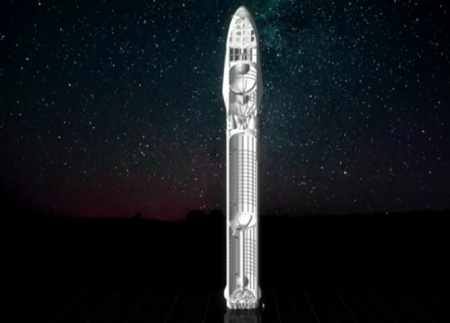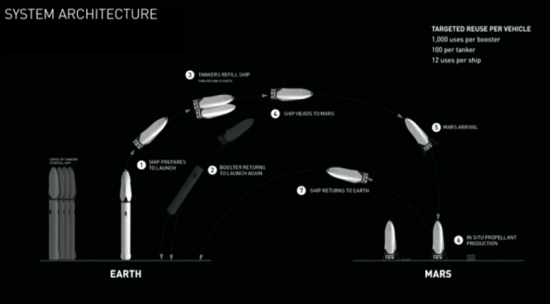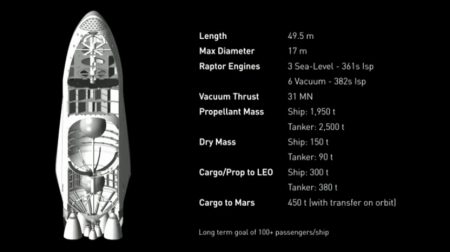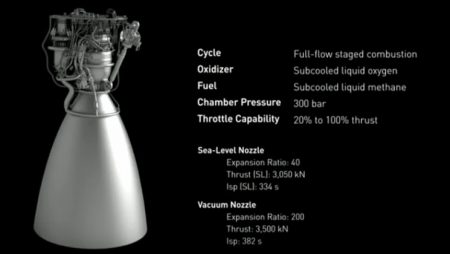September 28, 2016 – It is great to have a visionary at the helm of a company even if the vision described seems unimaginable based on current realities. But yesterday Elon Musk, founder and CEO of SpaceX, spoke to the 67th International Astronautical Congress in Guadalajara, Mexico, describing his ambitions to establish a city on Mars, home to hundreds if not thousands, using technology developed by his company in partnership with others and national space agencies.
In the middle of an investigation to determine what caused a Falcon 9 to explode at Cape Canaveral during a static fire test, Musk carries on with his vision of a fleet of reusable spaceships ferrying people between Earth and Mars, each capable of supporting up to 200 in the flight between the planets. His speech in Guadalajara was entitled, “Making Humans a Multiplanetary Species.” In it he described the survival forces driving humans to Mars. He talked about the SpaceX Interplanetary Transport System, a spacecraft that currently is a drafting-board concept. He also described successor rockets to the Falcon 9 that would be twice as powerful as the Saturn 5, the rocket that propelled Apollo to the Moon. These behemoths (see image below) would stand more than 90 meters tall (300 feet) and would totally reusable. The Interplanetary Transport Systems would remain in space moving between Mars and Earth on a regular schedule just like today’s airlines. Cost per seat according to Musk will be around $200,000 US. So instead of putting that kind of money into buying a home on Earth, intrepid adventurers could plunk down the amount on a ride to the Red Planet.
The way to make all this happen is to reduce the cost of going to space. SpaceX is already moving down this path with plans to take what it has learned from the so far five recovered Falcon 9 rocket first stages. Many SpaceX plans to reuse in future launches. demonstrating the capacity to dramatically lower mission costs to low-Earth orbit.
But a mission to Mars is far more complex than putting a satellite in orbit and recovering the launch rockets that got it there. For example Mars and Earth only achieve optimal launch proximity every 26 months. So planning a trip there is not like booking a flight anywhere on our planet.
Musk divides his mission to Mars plan into a series of discrete operations. The first involves building and launching the Interplanetary Transport System, a spaceship designed to carry cargo and passengers to Mars from Earth orbit. He would launch it with its fuel tanks dry. Then he would proceed to fill those tanks and provide necessary supplies through multiple launches from Earth providing a supply chain that would use the 26 months between Earth to Mars trips as a way to maximize the spaceship’s capacity and capabilities. This process would prove much less costly than launching the spaceship from Earth with full tanks and optimal payload.
Musk also wants to ensure, unlike the Mars One project, that the people who go to Mars can also return to Earth. So he intends his ships to be able to refuel when they get to Mars. That means developing the technology to harvest fuel from resources available on the planet so that the tanks can be topped up for the return flight to Earth. His choice of fuel would be methane combined with liquid oxygen. Methane can be produced on the Red Planet as well as oxygen harvested from what Musk describes as an almost unlimited supply of carbon dioxide and water. He envisions an initial propellant plant with liquefaction storage which would be expanded over time.
Musk imagines 10,000 flights from Earth each carrying 100 settlers. Based on the 26 month window that would mean the building of up to 1,000 Interplanetary Transports each capable of multiple reuse (up to ten times). To get to a Martian colony large enough to be self-sustaining, Musk estimates a city of 1 million, would therefore take between 40 to 100 years. If the carrying capacity of the Interplanetary Transports were to double then the period to reach that 1 million threshold would be considerably reduced.
The Interplanetary Transport (seen in image below) would be built out of advanced carbon-fiber. The fuel tanks would employ gaseous methane and oxygen to simplify fueling and refueling. The Transport comes with 9 engines and would weigh 450 tons when fully loaded.
Currently SpaceX is testing a new rocket engine designated Raptor. These engines are three-times more powerful than the Merlin engines that power Falcon 9. Seen in the image below, Raptor engines will be used for both the booster rocket and Interplanetary Transport. The booster will be configured with 42 engines clustered at its base. A single engine is seen in the image below. Combined the engines will provide multiple redundancy. That means a few of the engines can fail without impacting its mission to low-Earth orbit.
The plan would be to initially take 80 days to get to Mars and eventually reduce transit to only 30 days. Initial flights would be relatively expensive but eventually the cost to deliver one ton of payload would amount to $140,000 U.S. That yields a cost per ticket of approximately $200,000. Eventually the price could drop to as little as $100,000.
The timelines for this vision:
- Red Dragon launch to Mars planned for 2018.
- Second Red Dragon to go to Mars in 2020.
- Propulsion system development by 2019.
- Development of the first Interplanetary Transport System by 2020.
- Development of the booster rocket by 2021.
- Orbital testing of the spaceship completed by 2023.
- First flight to Mars within the window between 2024 and 2028.
To fund it all Musk envisions a public-private partnership. His motivation to accumulate his own personal assets he states is to fund this dream. There are few visionaries on this planet today so motivated. And if this dream becomes reality maybe the first humans on Mars will live in a city named after him.



















